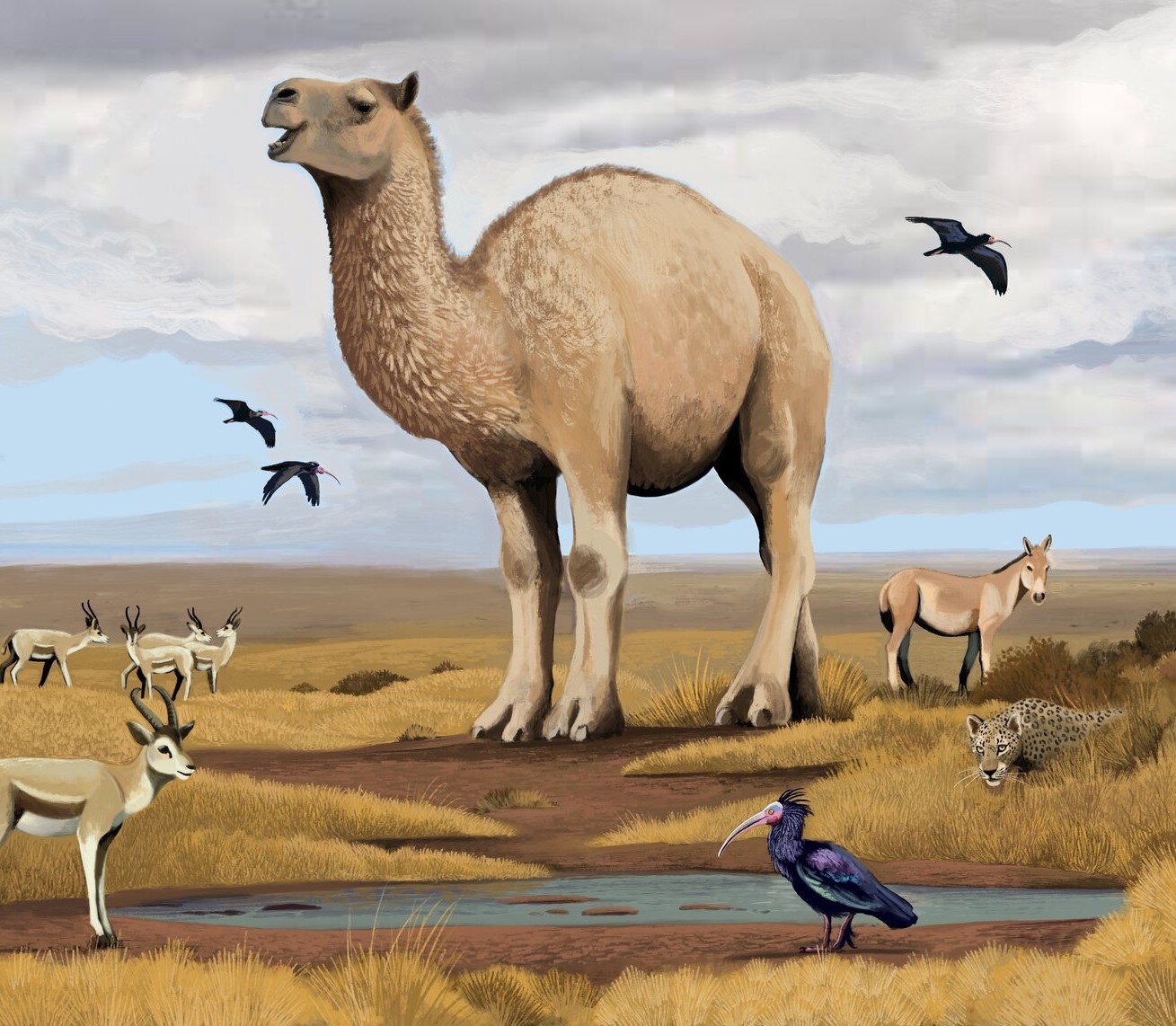Giant Syrian Camel (Camelus moreli)
Fig 1. The giant Syrian camel (Camelus moreli) at a watering hole in the El Kowm Basin in Syria, during the Late Pleistocene. Other species from the site pictured are the Syrian wild ass (Equus hemionus hemippus), leopard (Panthera pardus), goitered gazelle (Gazella subgutturosa), and Northern Bald Ibis (Geronticus eremita).
Taxonomy
Camelus moreli is an extinct member of the Old World Camels, belonging to the genus Camelus which contains the extant Bactrian Camel (Camelus bactrianus), Wild Bactrian Camel (Camelus ferus), and Dromedary (Camelus dromedarius) as well as a number of extinct species. The etymology of ‘Camelus’ is simply ‘Camel’, whereas ‘moreli’ is from the archeologist and paleontologist Philippe Morel, who did extensive work at the site where the species was discovered (2).
Distribution and Age
Camelus moreli is only known from the site of Hummal, located in the El Kowm Basin of Central Syria. The faunal material has not been directly dated, but the age has been inferred from the archaeological remains in the same strata. The accompanying tools belong to the Mousterian Technology age, which was present during the early Late Pleistocene, terminating around 50kya in the region (2). This places a tentative age of the material at 50-100kya. A specimen possibly referable to this species was found in Far’ah, Israel, also dating to about 50kya (2). A third putative site is in Sudan, where a large camel is associated with archaeological remains dating to 22kya, but this is poorly described and could easily be a recently dead hybrid between the Bactrian camel and Dromedary since these also reach large sizes (2). Due to the small number of fossil sites, both the geographic and temporal range is probably much greater.
fig 2. The known distribution of Camelus moreli is limited to the El Kowm Basin (Black fossil) and possibly Far’ah II (Red fossil). It may extend much further. Samples of nearby modern habitats are included.
Morphology and Ecology
The species was very large, weighing in at around a metric ton and attaining a shoulder height of about three meters and a total height of 4m (1). it considerably larger than any extant camelid and among Pleistocene camels is comparable only to Camelus knoblochi of Northern Eurasia, and possibly an undescribed Early Pleistocene species also found at El Kowm (2). The species has some fairly interesting characteristics, the skull bones indicate a relatively short face. Most uniquely the limbs are not as well adapted for lateral forces as other camel species, in addition to this, the spine also is less strongly built, one possible explanation would be that Camelus moreli had a reduced hump, or perhaps lack one altogether (2).
The species likely inhabited a dry-steppe habitat at El Kowm where it co-existed with a number of other megafaunal species. Most notably a second recently described species of camel Camelus concordiae co-occurred and presumably filled a somewhat different niche. Camels, equids, and gazelles are by far the most common megafauna, but the faunal assemblage also commonly contained the rhinoceros Stephanorhinus, a large bovid which was probably either Aurochs (Bos primigenius) or Pelorovis and a number of less common species (2). The area was also home to a number of predators, large felids are known from the area but have not yet been classified, likely both the Lion (Panthera leo) and Leopard (Panthera pardus) were present, the former of which would seem a likely predator of Camelus moreli. Hyenas and smaller canids are also known from the site (2).
Citations
BBC News (2006). Giant camel fossil found in Syria. Available at: http://news.bbc.co.uk/2/hi/science/nature/6035113.stm (Accessed: 3 May 2021).
Martini, P., Costeur, L., Le Tensorer, J-M., Schmid, P..(2019). ‘Chapter 5: A giant and a small camel lived side by side in the Late Pleistocene of Syria’ in: Martini, P.. (2019). Camel fossils from the El Kowm Basin, Syria. Diversity and evolution. PhD Thesis, University of Basel, Basel.


